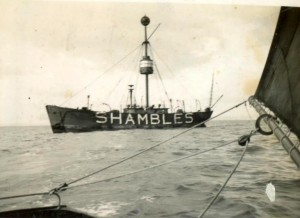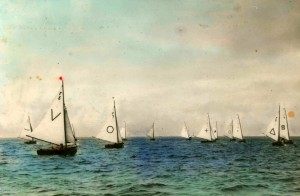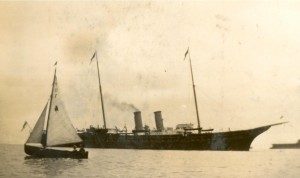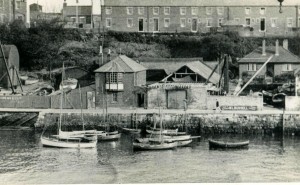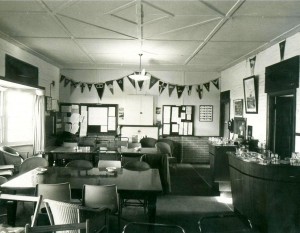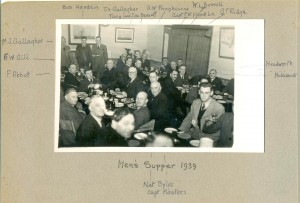The New Secretary
In the Autumn of 1934 Major Griffin was transferred to Gosport and was therefore obliged to resign the secretaryship, which he had taken over on the death of Mr. Haines. As Capt. Knight, the assistant hon. secretary, did not see his way to handling the full duties, the committee asked Mr. Gallagher to take over until the end of the financial year. That was eighteen years ago, and Mr. G. has served the club faithfully in the same capacity until the present day.
Soon after the transfer of Major Griffin, the Club lost another valuable member in the departure of Cmdr. Burton, who sold ‘Sparrowhawk’ to Lieut. H. Mead and went to live in Devon. One of the new Hon. Secretary’s first duties was to write the commander a letter of appreciation for the very considerable work he had done for the club, which indeed owed much to his energy, enthusiasm and racing skill.
The Commodore for the next two years [1935-1937] was Mr. George Cox, under whose flag the club experienced a fresh wave of prosperity with new boats, new trophies and no less than eighty new members, a rate of expansion which called for a material enlargement of the club premises.
New Boats
Z class, augmented by the two X survivors, ‘Ceyx’ and ‘Pixie II’, had recently enlisted ‘Quest’ [Col. Adams] and ‘Felicity’ [E. L. Pope] and was now joined by ‘Ultimus’ [W Flower Symonds], bringing the total, with our old friends ‘Windflower’, ‘Idler’ and ‘Lapwing’, up to eight. Y class, gaining Mr. K. T. Moyes’ 12 footer ‘Gull’ and Dr. Gerrard Pearse’s ‘Antelope’, mustered 14 boats; and the Falcons gained four additions, bringing their total in 1935 up to 20.
The new Falcons were ‘Gyrfalcon’ [F. R. Hillier], ‘Lanner’ [Dr. Harvey], ‘Buzzard’ [11] [Vl L. Bussell], and ‘Hobby’ [11] [G. Cox], the latter being a replacement for the Commodore’s existing ‘Hobby’ which he sold to Bridport. A fifth boat was ordered for the club’s first lady Falcon-owner, Miss Diana Stone, and this was met by selling her Mr. Bussell’s newly built Falcon, whose sail Miss Stone embellished with the Arabic figure 4. In July 1935 a further order was met by selling the new ‘Buzzard’ to Mr. C. R. Wrey, and Mr. Bussell – still boat-less – finally supplied his want by importing the old-timer ‘Kite’ from Poole, in exchange for Capt. Stayner’s ‘Honeybuzzard’ whose sail number [15] was bestowed on the new ‘Buzzard’.
In 1936 Mr.Gallagher bought a new ‘Glede’, disposing of the original to Tynmouth, and Mr. H. G. Rose made his debut in ‘Tarse’.
New Trophies
In April 1935 a letter was received from the Whitehead Torpedo Co, offering a cup to be competed for by Falcons in the Town Regatta, and to become the property of the member winning it three years running in the same boat. The company also offered £25 in Regatta prize money to be divided between the club’s three classes. These generous offers were accepted with the club’s best thanks and the Commodore wrote a personal letter of thanks to Mr. J. P. Davison the managing director, who was invited to become an honorary member of the club.
This public spirited firm had put up a cup for X-class boats in the 1934 Regatta, and this had been won by ‘Minnikin’ of Parkstone. The present trophy was of truly noble proportions, standing some 3ft. high and lavishly decorated. It is now in the possession of Mr. David Pitcher, who pulled off the hat-trick in ‘Peregrine’ with the aid of the whites of several dozen eggs!
A similar condition was attached to the Spooner trophy and David Pitcher carried this off also with three successive Whitsun Long Distance Race wins. Mr. Spooner replaced the Silver Falcon with a new and similar one [1936] and Messrs. Whiteheads likewise replaced their giant cup with another of equally embarrassing proportions [1939].
In this year also the Falcon Friday Trophy – a Silver salver -was presented by Dr. W G. Gallagher, a new committee member and owner of Erne. A series of six races on Friday evenings was specified, to end by July 1st, and at Mr. Pitcher’s suggestion the venue was a new dog-leg course [C] round the Middle and Bincleaves buoys.
The first season’s result of this series gave credence to the nautical superstition about not sailing on Fridays, since only two of the nine dates allocated produced any result, and these were each determined on one round!
Lady members were given a series of three races, the prizes [for the first four places on aggregate points] being the Echo Cup, Col. Boulton’s Cup [originally for Falcons v. X-class] and cash prizes by Messrs. Ridge and Wilkiinson.
The Cadet’s races were run on similar lines.
Mr. T. W. Graham [whose ‘Ceyx’ now raced in Z class] offered a trophy for a projected series of Long Distance races for Z class on Sundays, but this the committee declined with regret ‘in view of the club’s accepted practice of not racing on Sundays.’
This being the Jubilee year of King George V, the season opened with a special all-in handicap ‘Jubilee Race’ for a prize provided by the club.
Extensions
In order to deal with the flood of new members, special committee meetings were held every Saturday evening for the sole purpose of confirming the applications as they became due. Forty-eight new members were elected in 1935, as a result of which there was little more than standing room in the club on race nights, and when the autumn came the monthly suppers had to be limited to 30 through lack of space. In fact the club was once more getting too big for its boots, and something would have to be done.
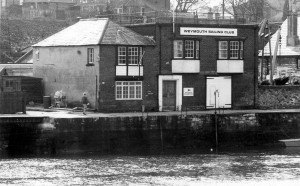
Wemouth Sailing Club in 1936 after building the new clubroom. The left-thand end dates from 1830 and the Longshed from 1923
In December the committee, deciding that a bold step was required, investigated the possibility of buying-in the club premises and the Long-Shed for which they offered Mr. Bussell £750. This offer was declined [the price asked was £900] but the benevolent landlord, after a conversation with Mr. S. Tewson [a committee member, architect and surveyor], suggested an alternative scheme. This was a plan for extending the club over the Long Shed, the cost of which Mr. Bussell undertook to bear himself conditional on an increase in rental of 6 per cent. on his capital expenditure.
This very co-operative offer was at once accepted and the position was put clearly to the A.G.M. in the committee’s report as follows:-
‘By reason of the growing membership of the club it has been thought advisable to increase the accommodation. It has been decided to extend over the adjoining building known as the Long Shed, in the form of one large room facing the harbour and three small rooms behind; forming bar, office and kitchen. The present bar will be converted into further accommodation for Lady Members, and the present office will be added to the Men’s Dressing Room.’
‘The extension will be covered by a flat roof from which a very fine view of races and surroundings can be obtained.’
A later resolution to the effect that, on completion of the extension., the existing club-room should be reserved for men, carries the implication that ladies were now admitted to the club premises without let or hindrance.
Building. to Mr. Tewson’s plans, proceeded throughout the early summer and in August the club took over the new premises for furnishing and decoration. Embellishments included charts and constructional models provided by Mr. Bussell and a board bearing the names of past Commodores [including the Franklin Club] presented by Mr. Pangbourne.
The official opening, on Oct 8th, 1936, was performed by the Mayor at a party with refreshments provided by the Commodore’s lady, Mrs.Cox, with the help of Mrs. Pangbourne and Mrs. Bennett,
This adoption by lady members of the role of hostesses began a tradition which revolutionized the organisation of social events such as inter-club races, and earned official commendation in the 1937 report thus:-
‘The lady members have helped greatly during the year. They were most useful as hostesses when other clubs visited us, and a number of them have done noble work in making cushions and mats. The Committee wish to thank these ladies.’ The delivery of this verbal bouquet may be regarded as the final recognition of ladies as potentially useful members of the club.
The Balance Sheet for 1936 showed that the committee’s faith in the club’s continued prosperity was well founded, their official comment being:-
‘The increase in receipts under all headings, due to the still rapidly increasing membership, has resulted in a gratifying surplus on the year’s working and indicates that there will be no question of raising member’s subscription to meet the additional expenses which will necessarily arise out of the extension of club premises.’
Special donations by members towards the furnishing fund totalled nearly £40, and House Committee sales showed an all-time record of £76-8s.
It needed a full working season to set the final seal of success to the venture, and this was recorded in the Report of the following year in these words: ‘1937 was the first complete sailing season since the premises were extended, and the result fully justifies the enterprise. The new rooms are found very useful and there is an excellent view from the roof.’
Feasts gastronomic and intellectual
The first annual Prizegiving Dinner and Dance was held in November, 1935, at the Burdon Hotel. It was a great success, but numbers had to be limited for this and the 1936 dance because only a small room was used, [the dining room]. In 1937 the annual report tells us ‘The Dinner and Dance was again highly successful: owing to using a larger room at the Hotel Burdon [the Hall], it was not necessary to limit numbers and the happy feeling which distinguishes the club generally was very apparent at the jolly affair on November 4th.’
‘Several members were unable to be present as the dance was not held in the week-end, and it is suggested that it be held on a Friday in 1938 instead of Thursday as heretofore.’ This was done, and the Sailing Club dance became a high-spot of the year.
Although the feminine element had now established itself in the club-house and at the Prizegivings, the men still retained a last stronghold in their Suppers. Held regularly on the second Thursday of each month throughout the winter season, their success was largely attributed to ‘the enormous work put in by Mr. Charles Flisher and the excellent cooking of Mrs. Skillman. ‘Favourite menus in those days of plenty included roast turkey, goose, duck and pork, pigeon pie, rabbit pie, jugged hare and ‘Frills’ or Weymouth Escallops boiled in milk.
In addition to the suppers there were ‘intellectual feasts’ – usually on the fourth Thursdays – in the form of talks by such authorities as Capt. Hamblin, Col. Sandes, and Messrs. H.A.G.Stevens, O.C.Vidler and A.M.Gill. The idea of combining the two types of feast is a post-war innovation.
One supper, held some years later, deserves mention because it commemorated a centenary. This took place in January 1939, and is recorded in the Annual Report of that year as follows:-
‘Members appreciate greatly the increased amenities made possible by the extension of the premises, but some … still have great affection for the old room, which was at one time Weymouth’s Custom House. On a window pane in this room a hundred years ago a loyal tide-waiter scratched with a diamond “God Save the Queen. E.Shearn T.W. 2/1/39.” The committee decided to dedicate the January supper to the commemoration of the centenary of this loyal sentiment and the idea – with other good things – ‘went down’ very well!
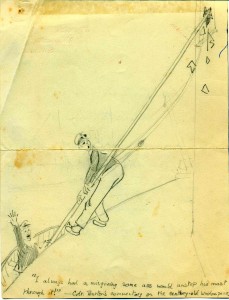
A contemporary letter from Comdr. Burton covering his subscription reads:- ‘I am very glad to see that the window pane had lasted out its century. I had always had a misgiving some ass would unstep his mast through it !’ The envisaged calamity is cleverly illustrated on the back of the letter.
